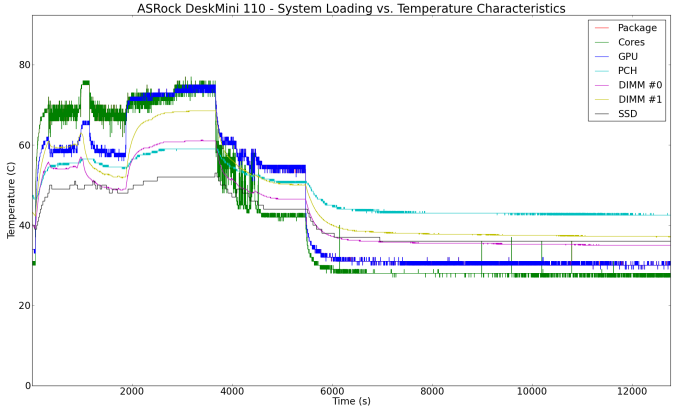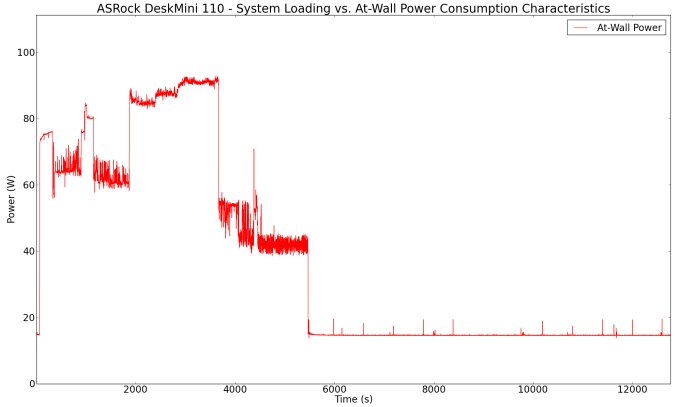ASRock DeskMini 110 mini-STX PC Review
by Ganesh T S on June 8, 2016 8:45 AM ESTPower Consumption and Thermal Performance
The power consumption at the wall was measured with a 1080p display being driven through the HDMI port. In the graphs below, we compare the idle and load power of the ASRock DeskMini 110 with other low power PCs evaluated before. For load power consumption, we ran Furmark 1.12.0 and Prime95 v27.9 together. The numbers are what one might expect for the combination of hardware components in the machine.


Our thermal stress routine starts with the system at idle, followed by 30 minutes of pure CPU loading. This is followed by another 30 minutes of both CPU and GPU being loaded simultaneously. After this, the CPU load gets removed, allowing the GPU to be loaded alone for another 30 minutes. The various clocks in the system as well as the temperatures within the unit are presented below.
According to the official specifications, the Tcase of the Core i5-6500 is 71C, and the BIOS performance curves are set to ensure that the processor doesn't go beyond that even under stress. Therefore, we see very strange package power / at-wall power consumption in the pure CPU loading case. However, things do stabilize at a higher power number when both the CPU and the GPU are loaded together.
Another important aspect to keep note of while evaluating small form-factor PCs is the chassis temperature. Using the Android version of the FLIR One thermal imager, we observed the chassis temperature after the CPU package temperature reached the steady state value in the above graph.
We have additional thermal images in the gallery below. The chassis temperatures are not a big concern even under extreme loading conditions.





















85 Comments
View All Comments
aethertron - Sunday, June 12, 2016 - link
I'm new to this, does the i5 HQ version draw the same power and get the same clock as the 65 W desktop version? I was thinking of this form factor because I was hoping to put full-power desktop components in a smaller form factor.extide - Monday, June 13, 2016 - link
That IS a full power normal desktop CPU, like you can buy at newegg.Gadgety - Wednesday, June 8, 2016 - link
@TS Ganesh " larger than the NUCs, but smaller than a mini-ITX build"Why do you not list case dimensions in the specifications as this is part of the point of evaluating this offering?
t.s - Wednesday, June 8, 2016 - link
seconded. A review about SFF, without the dimension is quit funny.ganeshts - Wednesday, June 8, 2016 - link
Approx. 6.125" x 6.125" x 3.125" by rough measurements. That comes to ~1.9L, but ASRock claims 1.82L in their press release. I might be off by 0.1" or so in the hurried measurements that I took.Btw, you can get an idea of how small the case is from the photo here: http://www.asrock.com/news/index.us.asp?id=3303
Gadgety - Wednesday, June 8, 2016 - link
Thank you.fanofanand - Wednesday, June 8, 2016 - link
Thank you Ganesh, I am awful at visualizing dimensions, that picture changes my entire opinion of this device. I went from simply being bummed about the PCI-e being at 2.0 speeds to being stoked at the possibilities. I am still holding out hope for a usable (FB, Youtube etc.) USB stick PC, but I may give up waiting (will likely be years for that to be realized) and just go for something like this. Great article Ganesh!QChronoD - Wednesday, June 8, 2016 - link
I was expecting to see a picture of this next to a modular PSU with the caption of "Can you guess which is which?"Michael Bay - Saturday, June 11, 2016 - link
Same here, looks just like a fancy PSU would.Eden-K121D - Wednesday, June 8, 2016 - link
Where is the GTX 1080 review ?